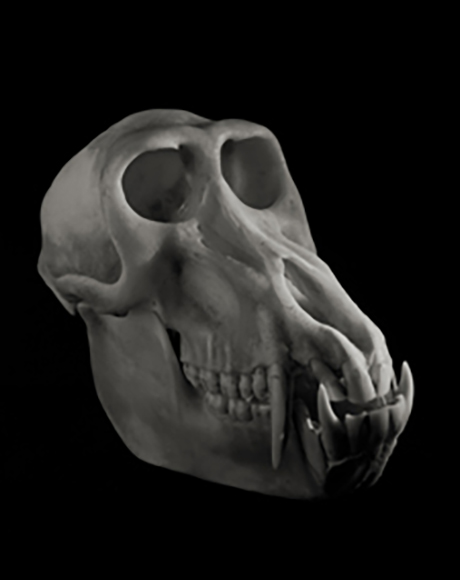 Tsuyoshi Saeki, Editor-in-Chief, The Feel of Wonder
Tsuyoshi Saeki, Editor-in-Chief, The Feel of Wonder
October 19, 2013
Last night I stopped by Zeit-Foto Salon in Tokyo’s Kyobashi district to see Faraway, an exhibition by Yumiko Izu that highlights her commitment to remaining analog in this age of digital ascendency. Looking at her platinum-print photographs of animal skulls taken with an 11×14 view camera, I was reminded that the allure of photography lies in its concentration of substance—capturing as it does for us the continuity of time in a single still image rendered by a chemical reaction.
In our lifeworld today, the one-zero polarity of digital thinking has stripped away an enormous amount of important information—information that in truth we need the most. Things that defy description. Things whose real nature remains elusive to us no matter how carefully we watch and listen, and yet we know to be precious just the same. These gray areas are really the more significant realms for a life lived meaningfully. Take “death” for instance. From a digital perspective, its valence is like zero—something like “the end” or “nothing.” But do we really want to view something that awaits all of us in that way? Don’t those definitions dismiss something that’s key to our deeper experience of life itself?
When flesh gives way to bare bones, we’re left with an even greater impression of that being’s substance than when it was cloaked in skin and muscle. The skeletal frame is truly profound. Flesh carries too many different meanings. With that polyvalence removed, we feel more strongly the organism’s inherent matter, its atomic essence. It emits, ever so quietly, a certain kind of energy—something like a voice that was difficult to hear when it was still encased in flesh. Garbed though we observers are in our own flesh bodies, upon hearing it now the voice resonates within us. It is the voice of spirit.
The flesh body is destined to perish eventually, a fact we are helpless to do anything about. Facing a skeleton, we become consciously aware of the bones that support our own bodies. Our inner voice—spirit if we’re going to call it that—can be thought of as a quiet energy released by the very atoms of our bones. From the most ancient times, people have interred bones with ceremony. Isn’t that precisely because these fleshless artifacts possess some quality that makes us more receptive to spirit? Today, cremation and the retrieval of cremains for internment have become so commonplace that perhaps the mystique of the ritual is no longer there. Even so, most of us respond to the sight of bones with some sense of awe. It seems to me that we all share an innate understanding that spirit abides within them.
Capturing that subtle voice—moreover, presenting its message intact in a form for others to witness—is a time-consuming process that demands much careful thought. Far more than a mere record, Izu’s photographs, taken with an ultra-large format camera and rendered as true-to-size contact prints, seem the very embodiment of their subjects’ timeless essence. Faithful to the meaning of “photo-graphy”—drawing with light—they underscore her determined effort to reveal truth itself, manifest as substance.
One needs to be ready to see the works of Faraway, the nature of its subject being what it is. Still, taking pause to consider the ultimate phenomenon of death rewards us with a greater zest for the life we have. There is no avoiding the demise of our flesh body, but we can find solace in the knowledge that something eternal rests within us all, whether it be bones or spirit. Death is something ever present within the living self. That’s how I like to see it.
Review
Faraway: On the Potency of Death
東京の京橋にあるzeit-foto-salonに、 井津由美子の写真展「Faraway/闇の彼方へ」を見に行った。様々な動物の頭蓋骨の写真は、11×14の大きなフィルムカメラで撮影し、プラチナプリントの密着焼きで制作されたものだ。 デジタル全盛の時代に、敢えて、アナログに徹しきった作品。このような作品を見ると、改めて写真の力というのは、化学反応によって時間の連続性を静止画に閉じ込めることによって生じる、濃密な物質感にあると感じる。
私たちが生きている世界には、デジタル思考の0か1が削ぎ落してしまっている大切な情報が膨大にある。言うに言われぬもの。じっくりと耳を傾け、目を凝らしても、明確にはわからない、けれども、何かとても大事なもの。そういうものこそ、生きていくうえで、実はもっとも大事なものだ。 例えば「死」ということ。デジタル思考で、死を伝えると、「終わり」とか、「何もない」ということになってしまう。でも、私たちが避けて通れない『死』というものを、そのように処理してしまっていいのか。 そのように決めつけてしまうことで、私たちは、生きていく上でとても大事な何かを失ってしまうのではないか。
骨格というのは、実に不思議だ。骨になると、肉の時よりもさらに物質感が増す。肉は、いろいろな意味を纏いすぎている。それらの意味を削ぎ落していくと、物質つまり原子の塊であることがより強く感じられる。その原子の塊は、じんわりと何かしらのエネルギーを放出している。それは、肉体に包まれていると聞き取りにくい声とも言える。その声は、肉体をまとう自分の内側にも響いており、 ”魂の声” といっても差し支えない。
肉体というのは、やがて滅びる宿命であり、それは、人間にはどうしようもない、大いなる事実だ。その事実が語りかけてくるのは、肉を削ぎ落された骨だけれど、その骨は、自分の肉体の中にも歴然とある。骸骨に向き合うことは、自分の中の骨を意識することでもある。 生きている自分の内側から自分に語りかけてくる声を、魂というならば、まさに魂は、自分の骨という原子の塊が発する微妙なエネルギーだとも言える。それゆえ、肉が削ぎ落された骨は、より魂を感じさせる何かであり、だからこそ古代から今日に至るまで、人々は、骨を埋葬してきたのではないか。 人が死んだら、肉体を焼いて、後に残った骨を拾い集めて埋葬することは、習慣化されて当たり前のことになってしまって、そこに深い意味を何も感じないけれど、誰しもその骨に何か特別な思いを抱く。骨には魂がこもっていると、人々は、潜在的に分かっているのではないか。
こうした微妙な感覚、微妙な声を、表現という手段を通じて伝えていこうとする場合、 微妙で大切なものが削ぎ落されてしまわぬように、時間をかけて丁寧に取り組んでいかなければならない。 このたびの井津由美子の巨大カメラで撮影して骨が発している念を封じ込めたようなフィルムを、引き延ばしすることなく、つまり等身大の密着焼きで焼き付けたプリントは、物を写すという程度の意味を超えて、まさに写真という字のとおり、真を写した物質に、限りなく近づいていこうという気迫を強く感じる。
その表現された『骨』の作品「Faraway」を見ることにも、覚悟が必要だ。 しかし、それだけ『死』というものを突き詰めて自分の中に置く事が、生のエネルギーになる。 肉体が滅ぶことは避けられないゆえに、生ある自分の中にも、骨として、魂として、何か永遠性を帯びたものが確かにあることを意識し続けることに、救いがある。 死は、生きている自分の中にも、常にあるもの。そう理解したい。
佐伯剛(風の旅人 編集長)
2013年10月19日